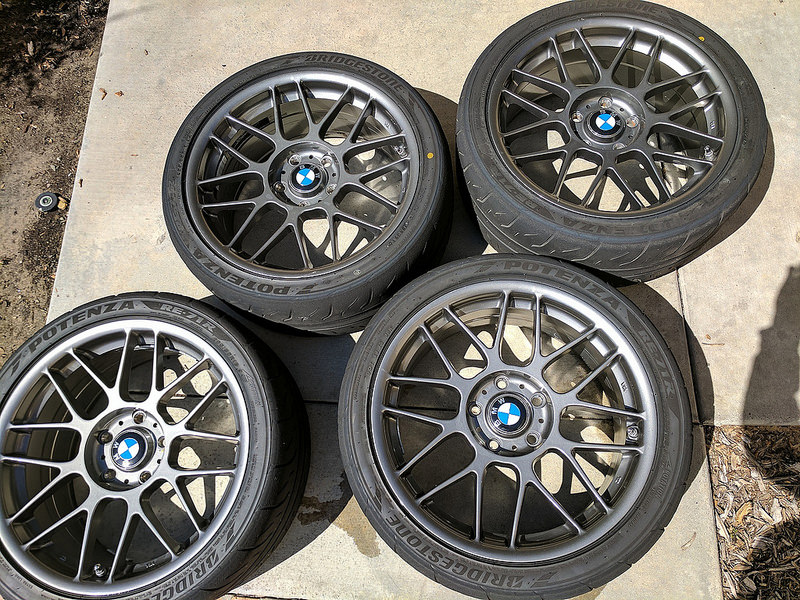Weight is directly related to horsepower. It is estimated that every
seven pounds you eliminate, your car gains the equivalent of one horsepower. There are many benefits to reducing unsprung weight. One of the most noted is that, 2.2 lbs of reduction in unsprung weight is roughly equal to
13 lbs reduction in sprung weight.
One easy way to reduce unsprung weight is the use of lighter weight wheels. By reducing the weight of the wheels, you also reduce the gyroscopic effect. The gyroscopic effect is the force that is generated from a spinning object. To get an idea of what this is, hold a bicycle tire in your hands and spin it. Now try and change the direction of the wheel. You will notice it is hard to do especially if the wheel is heavy. By reducing weight in the wheels you will reduce this effect resulting in better handling during cornering and improved acceleration. Magnesium wheels are the choice for most Superbike racers, and some are even going to carbon fiber but these are very expensive and typically not as durable as cast aluminum.
So, if you can remove 70 lbs from your car, it’s like adding 10 hp. Better yet, if you remove 20 lbs of unsprung weight (say 5 per wheel), that’s like removing 120 lbs of weight, which is like adding 17 hp.
If you remove 20 lbs of unsprung weight (say 5 lbs per wheel), that’s like removing 120 lbs of weight!
This is why performance minded racers and drivers are constantly seeking ways to reduce not only weight but more importantly unsprung weight. I have been considering new wheels for my e36 m3 track car and I have zeroed in on Apex 17×8.5 wheels that only
weigh 17.2 pounds each. The stock e36 m3 wheels my car came with weigh 22 lbs per corner!

1 pound of unsprung weight can equal to 10 lbs sprung weight and that each 10 unsprung lbs reduction roughly equals 10 whp or 0.1 sec in the quarter mile.
Common wisdom holds that lightweight wheels are better. Reducing unsprung mass should help a car’s suspension work more efficiently. Reducing rotating mass will also make the car accelerate and stop faster.
But how big of an effect is this?
Grassroots Motorsports have compared light and heavy wheels a few times before, and the results consistently showed a negligible difference in autocross times–even with extreme differences in wheel weight. Of course, autocross testing involves a lot of variables, including changing track conditions and driver fatigue. In a new test, they decided to see what effect light weight wheels have on track lap times. The heavy wheels for their test were a set made by a now defunct company Masitaly. The light ones were the legendary Volk
TE37 wheels.
On the track, Grassroots tested the heavy Masitaly wheels first, then the lightweight Volks. Then they retested the heavy wheels to correct for any changes in weather, track conditions, and the driver becoming accustomed to the course. Their test showed clear differences both on the track and at the drag strip. Times were substantially worse with the heavy wheels, which slowed the car by 0.31 second on the average lap and 0.46 second on even the best lap. Even though Alan’s final run on the heavy wheels was substantially quicker, it still was 0.16 second behind his best time on the light wheels.
Times were substantially worse with the heavy wheels
Lap times in seconds:
|
Masitaly |
Volk TE37 |
Mas (rerun) |
| Bryn’s average |
56.99 |
56.32 |
56.63 |
| Bryn’s best |
56.57 |
55.85 |
56.39 |
| Alan’s average |
58.02 |
57.26 |
57.36 |
| Alan’s best |
57.68 |
57.06 |
57.22 |
0-60 times:
| Volk TE37 |
8.61 |
| Volk w/ ballast |
8.75 |
| Masitaly |
9.04 |
Our zero-to-60 launch was our big test of angular inertia, and it showed substantial results. We ran three tests here, the third with the lightweight wheels and an additional 42 pounds of ballast in the trunk. This would illustrate the difference made by the fact that the heavy wheels aren’t just weighing down the car, they’re increasing the amount of energy required to spin them. That test was fruitful, too. Though the ballast slowed the car’s zero-to-60 time by 0.14 second compared to the Miata equipped with simply the light wheels, putting that weight on the hubs slowed the car by an additional 0.29 second.
Read more about
Grassroot’s test results here.